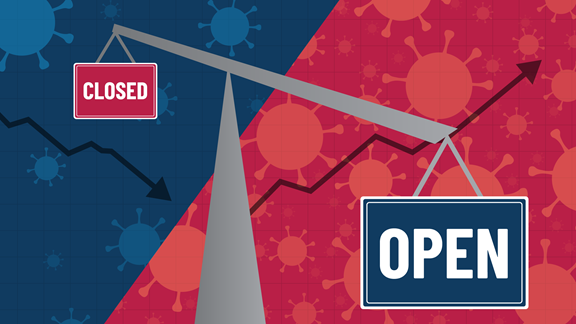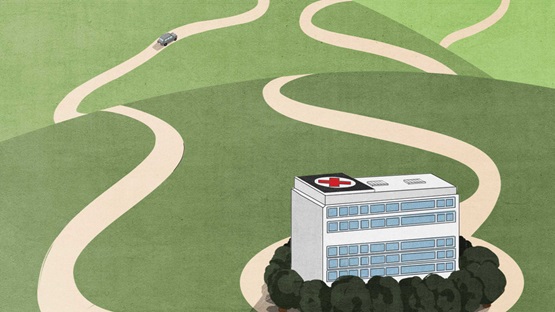Economists have generated a massive body of new research since the COVID-19 pandemic emerged. But little attention has been paid to the fate of emerging markets—nations that range widely in population but share weak economic fundamentals, including substantial indebtedness to the rest of the world.
This debt, it turns out, can be deadly.
As small as the Maldives, as large as Brazil, emerging markets have long borrowed from international institutions and private investment funds. But fragile economies—volatile export prices, weak industrial sectors—frequently lead their governments to default on foreign loans. Economists who study these “sovereign debt crises” hope to understand their causes and design policies to avoid them.
A recent staff report from the Federal Reserve Bank of Minneapolis analyzes how debt crises alter the math and mortality of pandemic health-wealth trade-offs. What effect does chronic debt pressure have on the balance between public health and economic well-being? The conclusion is bleak: “Economies that start the outbreak with more debt will suffer … more fatalities and more prolonged defaults.”
Debt raises costs, alters outcomes
Debt makes life-saving shutdowns more expensive and therefore less likely, according to the study. Limiting activity to curb contagion lowers economic output—the standard concern. But it also decreases the government’s capacity to repay foreign debt, adding to the expense. In that sense, chronic debt is an underlying condition that makes pandemic more deadly. Treating it becomes substantially more expensive.
“Debt alters the outcome of the epidemic because it changes the costs of lockdowns,” writes Cristina Arellano of the Minneapolis Fed, who co-authored “Deadly Debt Crises: COVID-19 in Emerging Markets” with Yan Bai of the University of Rochester and Gabriel Mihalache of Stony Brook University. “A highly indebted economy, with a looming debt crisis, chooses a less strict path of lockdowns … [and] ends with a higher death toll from the epidemic.”
There is, fortunately, a clear policy option: debt relief. The economists evaluate financial assistance policies that would soften debt burdens and find that they have large social benefit, helping avoid debt crises and giving governments sufficient economic leeway to implement stricter lockdowns. Breathing room, literally.
Integrating debt
To analyze how sovereign debt stress impacts a pandemic economy, the researchers integrate two frameworks:
- A standard epidemiological model with people susceptible to coronavirus, infected by it, and recovered from COVID-19.
- A sovereign debt model of a macroeconomy faced with external debt pressure.
Their hybrid model reveals the joint dynamics of an afflicted economy balancing protection of public health against sustained economic activity, and that same economy also coping with pressure to repay loans from international lenders.
In the painful dilemma now confronting all nations, economic shutdown saves lives by slowing the spread of infection, but it also closes businesses, throws people out of work, and dries up tax revenues. Extraordinary public health needs strain government budgets. Other crucial social programs go unfunded.
The model highlights the additional stress created by foreign debt. Economic shutdown to fight the spread of pandemic depletes funding for rising domestic needs. Paying back foreign loans amplifies the financial burden. For government policymakers, foreign debt puts a thumb on the scale toward reopening the economy to generate revenue; it thereby widens the potential for more viral infection.
Quantifying death and debt
For a baseline, the economists designate a moderate debt-to-GDP ratio of 30 percent. Their hybrid model, blending economics with epidemiology, estimates that a government trying to optimize national well-being that includes per capita consumption and lower mortality risk would lock down the economy two months after the epidemic begins, sustain it for eight months, and relax intensity after three months. This policy would cut the death toll in half, from a 1 percent rate to about 0.5 percent. Output would decline by 19 percent. The debt crisis would last 43 months.
A government facing a higher debt burden would choose a less strict lockdown path. Higher debt limits the government’s ability to borrow more from abroad—a pressing need as the country locks down. Debt thus motivates the government to open the economy sooner, even though that raises the infection and death rates.
“Lockdowns,” observe the economists, “are effectively an investment to save future lives,” but that investment becomes more costly with additional debt.
Timing, too, makes a difference. The economists compare their optimal lockdown (start at two months, sustain eight months, gradually open after three) against a shorter, earlier lockdown (start at one month, end four months later).
Both lockdowns reduce death tolls, but the short lockdown saves fewer lives. It reduces output slightly less than the optimal lockdown, but it generates a more severe debt crisis. “The higher death toll and more severe debt crisis leads to a consumption equivalence loss higher than in the baseline,” they write.
These theoretical scenarios provide practical lessons for emerging countries, say the economists “Our experiments suggest that it is best for these countries to open up only very gradually. Such policy would not only help with the health crisis but also it can potentially alleviate the severity of the debt crisis.”
Regardless, lockdowns are costly, not only in reducing output and consumption, but in potentially leading to prolonged and deep debt crisis. Ecuador, Argentina, and Lebanon have already defaulted, and other defaults seem likely.
Debt relief
The economists’ last step is gauging the impact of debt relief. If a financial assistance policy lowered an emerging market’s debt burden, what affect would that have on the course of debt, output, consumption and, ultimately, life?
In brief, “debt relief programs can have profound positive effects,” the economists find. By supporting consumption, reducing the severity of the debt crisis, and allowing sustained lockdowns, debt relief “can save lives.”
The economists evaluate debt relief by considering a policy that would reduce a country’s debt by 10 percent (debt-to-output). The model runs through several experiments, altering the country’s initial level of debt from as low as zero debt to as high as 50 percent. Total return to the financial assistance policy is calculated as gains for the country, plus gains for the lender, minus the cost of assistance.
Returns vary with the country’s initial debt. Nations with little debt have enough resources to weather the epidemic, and assistance won’t change much. A 10 percent cut won’t alter outcomes much for severely debt-burdened countries either. But for countries with moderate debt, modest assistance can have major benefits. It shortens the debt crisis and allows for “better mitigation policies that save lives.”
The findings suggest that debt relief policies aimed at benefiting countries (rather than lenders) should be targeted toward countries on the brink of a debt crisis. Debt relief allows them to avoid falling deeper in debt while saving lives from prematurely relaxing shutdowns.
Conclusion
As the pandemic evolves internationally, emerging markets are likely to fare worse than most others. Many depend on export markets and international tourism that have collapsed. Foreign remittances have declined as migrant workers are laid off. Health systems and social programs were fragile before the pandemic.
Sovereign debt crises will only exacerbate these conditions.
Arellano, Bai, and Mihalache’s research shows that foreign debt in emerging markets diminishes capacity for dealing with the pandemic and for sustaining economic activity. Lockdowns save lives, but reduce consumption and exacerbate debt crises. Debt burden therefore “leads to less aggressive lockdown choices and a more severe health crisis.”
More hopefully, the research also demonstrates that targeted debt relief policies can significantly benefit these nations, by strengthening economies, curbing debt crises, and saving lives.





